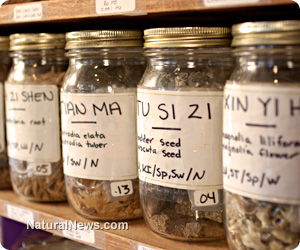
Herbal medicine saves lives, lifts villages out of poverty
Wednesday, April 30, 2014 by: PF Louis
Tags: herbal medicine, poverty, medicinal trees
- Newly released JFK files reveal Pentagon's role in creating Lyme disease and covid in the same lab
- DEADLY DECEPTION: How COVID vaccines increased mortality rates and why authorities hid the truth
- CDC finally halts $11 billion COVID funding scam as health officials admit the ‘pandemic’ was a fraud
- Here are TEN all-natural ways to protect your garden without using harmful chemicals
- GAIN-OF-FUNCTION CAT-BIRD-FLU now on the rise as nearly a dozen cats in Colorado "test positive" for Bird Flu due to contaminated cat food
- Ginseng's hidden anti-aging power: How compound K is rewriting the rules of skincare
- “Endgame: The Hidden Agenda 21” unveils a world of conspiracy and control
- ATTENTION PRESIDENT TRUMP: Please WITHDRAW your nomination of Dr. Susan Monarez for CDC Director as she is a VAX FANATIC and TOXIC JAB ZEALOT
- Senate Democrats deny censorship industrial complex existed, defend government's role in silencing dissent
- Scientists demand FDA withdraw mRNA COVID vaccines amid contamination and gene therapy concerns
- “The shame of Minnesota”: Somali immigrants behind $250 million child nutrition fraud in largest COVID-era scam
- L.A.'s rebuilding nightmare: Only 4 permits issued after fire destroys 6,000 homes
- Former Congresswoman exposes CCP's deep infiltration of California through universities, ports, and fentanyl
- Despite surge in MMR vaccination in Texas, measles outbreaks continue: Is VACCINE SHEDDING fueling the spread?
- Judicial bias exposed: Judge who blocked Trump's gang deportations attended secretive left-wing conference
- BPA: The hidden hormone disruptor sabotaging your health - and how to fight back
- PROCESSED TABLE SALT in foods found to fuel depression
- Chewing gum's dirty secret: How your daily habit could be flooding your body with microplastics
- Newly released JFK files reveal Pentagon's role in creating Lyme disease and covid in the same lab
- Elon Musk: Aliens could be here on Earth RIGHT NOW
- Festive flavors: The sweet history, nutritional profile and health benefits of pecan pie
- Trump reverses course on Gaza plan, says “nobody is expelling Palestinians”
- Reclaim your health: How midlife exercise reverses years of inactivity
- Big Pharma's $8 Billion bribery scheme exposed: how doctors are pushed to prescribe junk science, not heal
- Boys are back in town: Trump’s patriotic alpha crew takes the wheel while toxic females ride in the backseat
- EPA advisor admits the agency is funneling billions to climate groups ahead of Trump’s return to White House
- Space war brewing? Russia threatens to destroy Starlink satellites
- Survival 101: Effective EMF blocking techniques
- A lack of integrity in Academia: Harvard professor found GUILTY of fraudulent research to promote CRT theory
- Mike Adams Sermon 66: God will DESTROY ISRAEL for its wickedness
- 5 Simple steps to boost your brainpower: How to strengthen executive function in a distracted world
- Rep. Nancy Mace introduces bill to ban biological males from female facilities on federal property
- Sugarcane extract superior to cholesterol-lowering drugs?
- WHO focusing more on policing speech about public health and implementing global surveillance systems
- Pilots report mysterious lights 'moving at extreme speeds' across Oregon skies
- Dr. Mike Yeadon releases 15-minute testimony - WATCH - about genocidal intent of COVID “vaccines”
- EPA advisor admits the agency is funneling billions to climate groups ahead of Trump’s return to White House
- The Health Ranger releases “Vaccine Zombie” song and music video, using AI-animated zombies for the music video
- California's social media censorship law struck down: A victory for free speech or a threat to online safety?
- Dr. Mike Yeadon releases 15-minute testimony - WATCH - about genocidal intent of COVID “vaccines”
- The pandemic as a tool for INDOCTRINATION: Understanding “The Indoctrinated Brain” by Dr. Michael Nehls
- Florida takes a stand: DeSantis proposes permanent ban on mRNA vaccine mandates
- Mike Adams releases country western hit single: Goin’ Back in Time is Comin’ Home
- Mike Adams releases music poetry sensation: A Child of God
- “Why we influenced the 2020 elections”: Facebook files reveal the coordinated effort to bury the Hunter Biden laptop story
- RFK Jr. clears key hurdle: Sen. Susan Collins backs controversial HHS nominee, signaling a new era for health policy
- Unpacking the Lies That We’ve Been Fed – new song and music video released by Mike Adams, the Health Ranger
- Mike Adams releases new song and music video: Nothing More Disgusting Than a Globalist
- Newly released JFK files reveal Pentagon's role in creating Lyme disease and covid in the same lab
- Congratulations to the FULLY UNVACCINATED as you resisted the COVID-19 PROPAGANDA MACHINE fueled by over $100 BILLION
- Michigan sheriff announces criminal investigation into 2020 election crimes, Dominion Voting Systems
- Israeli soldiers accused of even more torture and abuse in the West Bank
- Migrants are taking advantage of recent hurricanes to scam residents and loot their homes
- House Intelligence Committee calls for the ARREST and PROSECUTION of Dr. Anthony Fauci
- Red Cross issues warning to stop blood plasma donations from vaccinated people
- Scientists confirm: GENIUS brain function can be spontaneously unleashed in humans without any apparent cause
- EPA advisor admits the agency is funneling billions to climate groups ahead of Trump’s return to White House
- HYSSOP: What research reveals about the health benefits of this ancient holy herb
- Two containers with completed ballots fall out of truck in Florida
- Fully vaccinated about to see “tsunami” of illness and death, warns virologist
- Global leaders unite to clamp down on “misinformation” with UN-backed Cascais Declaration
- BREAKING: 2025 NDAA authorizes mandatory military draft of WOMEN across America… as Pentagon pursues global NUCLEAR war with both Russia and China at the same time
- Michael Yon warns of a ZIONIST TAKEOVER in Trump’s second administration
- BOMBSHELL: DNA testing kits are a SCAM to develop ethnic-specific bioweapons
- Ozempic and Wegovy weight loss drugs are injectable LIZARD VENOM PEPTIDES that may unleash a devastating wave of organ failure… side effects align with symptoms of SNAKE BITES
- Israeli soldiers accused of even more torture and abuse in the West Bank
- These 13 countries just signed an agreement to engineer a global FAMINE by destroying food supply
- NASA admits that climate change occurs because of changes in Earth’s solar orbit, and NOT because of SUVs and fossil fuels
- RFK Jr. clears key hurdle: Sen. Susan Collins backs controversial HHS nominee, signaling a new era for health policy
- Sermon 30: How Jesus reveals Caesar’s FAKE CURRENCY and FALSE AUTHORITY
- Coriander seeds: Ancient medicine backed by modern science
- Arizona officials claim Maricopa County needs 10-13 days to tabulate results of the election
The grassroots herbal cultivation boom in Vietnam
Apparently, it all started with an impoverished villager who had been a teacher in his village for several years. Now 64, Briu Po was the local high school biology teacher, but he was living in poverty despite his education and position.Po was invited by Dr. Ngo Van Trai of the Central Institute of Pharmaceutical Products to study the local terrain to determine suitability for cultivating herbal remedies such as Morinda officinalis.
Upon hearing that this herb was on the verge of extinction, Po urged his wife to start planting their own. Po recalls, "In 2007, we tried growing 900 plants. Our villagers thought we were insane as they believed that the plant belonged to God, and hence, could not be planted by humans. They thought that all of our plants would die."
After the first harvest, Po and his wife netted $2,500 US, more than they've ever had at any one time, for their Morinda officinalis roots sold to local herbal pharmaceutical companies. Then the other villagers started their own planting. They were impressed enough to realize that God would let them cultivate the plants and followed Po's example.
The whole village soon had 6,000 Morinda officinalis plants with more from Po, who expected to get even six times more remuneration this time around, according to the report from the English edition of VietNamNet Bridge.
Dr. Mai Van Thanh returned to Vietnam from China to invest in the burgeoning village grassroots herbal farming scene. He intends to ensure that farmers don't use any artificial fertilizers or other chemicals used in modern conventional farming to maintain the purity required for medicinal herbs.
The prime minister of Vietnam, Nguyen Tan Dung, has approved an overall plan to develop traditional medicinal materials until 2020 with extensions envisioned through 2030. Hospitals and medical practitioners are pleased with these plans that will enable them to use locally produced clean herbs for natural medicines.
An anecdote that typifies the growing resurgence of herbal medicine demands in Vietnam comes from 50-year-old Hoang Thi Yen. She proudly asserted that she is still alive and healthy thanks to the herbal remedy known as Trinh nu hoang cung (Crinum latifolium).
It reversed her uterus tumor's growth, which became much smaller from drinking the herbal solution daily. She shied away from surgery but realized that she could drink the Crinum latifolium daily without concerns of side effects.
Similar opportunities elsewhere
On the other side of the planet in the African nation of Kenya, Jonathan Muriuki, lead author of a study in that nation sponsored by the World Agroforestry Centre (ICRAF) and published in the journal Forests, Trees and Livelihoods commented on how overharvesting wild herbs leads to depletion of supply as demand grows.Although Kenyans have traditionally relied on using herbal and medicinal tree remedies in rural areas, more urban dwellers throughout Africa and elsewhere are increasing demands for herbal medicines that lack the proper infrastructure to be provided to such markets.
Jonathan sees this as an opportunity for Kenyans to rise from poverty, as infrastructure would provide many new openings within the herbal arena. To improve the market in traditional medicines, the study recommends linking traders to farmers in the form of grower groups, especially women, which could initially focus on the most traded species of the trees and herbs.
"Farmers stated they would sell medicinal products if they had access to market opportunities," said Muriuki. "Access to markets for other tree products has led to increased cultivation of tree species providing these, so it would be fair to assume the same could be applied for medicinal trees."
Sources for this article include:
http://english.vietnamnet.vn
http://www.motherherbs.com
http://www.sciencedaily.com
http://worldagroforestry.org
http://science.naturalnews.com
Herbal medicine at FETCH.news
Get independent news alerts on natural cures, food lab tests, cannabis medicine, science, robotics, drones, privacy and more.
Take Action: Support Natural News by linking to this article from your website
Permalink to this article:
Embed article link: (copy HTML code below):
Reprinting this article:
Non-commercial use OK, cite NaturalNews.com with clickable link.
Follow Natural News on Facebook, Twitter, Google Plus, and Pinterest
Science News & Studies
Medicine News and Information
Food News & Studies
Health News & Studies
Herbs News & Information
Pollution News & Studies
Cancer News & Studies
Climate News & Studies
Survival News & Information
Gear News & Information
News covering technology, stocks, hackers, and more



"Big Tech and mainstream media are constantly trying to silence the independent voices that dare to bring you the truth about toxic food ingredients, dangerous medications and the failed, fraudulent science of the profit-driven medical establishment.
Email is one of the best ways to make sure you stay informed, without the censorship of the tech giants (Google, Apple, Facebook, Twitter, YouTube, etc.). Stay informed and you'll even likely learn information that may help save your own life."
–The Health Ranger, Mike Adams













































